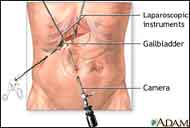Laparoscopic Cholecystectomy
The Gallbladder
The gallbladder is a small sac located under the liver. It stores and concentrates the bile produced in the liver, which aids in the digestion of fats. Bile is released from the gallbladder to help with the digestion of food, especially fats, in the upper small intestine. Conditions which slow or obstruct the flow of bile out of the gallbladder result in gallbladder disease.
Types and Treatments of Gallbladder Disease
Gallbladder surgery is done to treat gallbladder disease such as gallstones, infection or inflammation (cholecystitis), severe abdominal pain due to gallbladder disease and blockage of the bile drainage tubes (biliary obstruction).
Gallbladder surgery can be done through an abdominal incision (open cholecystectomy) or through several small incisions (laparoscopic cholecystectomy) with a special scope (laparoscope), which is actually a small video camera.
Often, this surgery is done because of gallstones that are causing a problem. Not everyone has gallstones, and not everyone who has gallstones has problems with them. But when a person who has gallstones does develop symptoms, more often than not the best thing to do is to remove the gallbladder because recurrent symptoms are likely.
Symptoms of Gallstones
Symptoms caused by gallstones are typically pain in the abdomen, usually right under the right ribcage and sometimes right under the breastbone. When this pain comes and goes, often after eating fatty or spicy food, and is due to gallstones, the condition is called "biliary colic." When the pain persists more than a few hours and keeps getting worse, it is called "cholecystitis."
Most gallbladder surgery today is done using laparoscopic surgical techniques, in which narrow instruments, including a camera, are introduced into the abdomen through small puncture holes.
Nausea and a bloating sensation are also common with gallstones, and yellow jaundice of the skin may develop. Jaundice is a sign of a gallstone that may have escaped the gallbladder and is now wreaking havoc farther on down the digestive system. This can lead to severe complications, like pancreatitis, or inflammation of the pancreas.
Laparoscopic Cholecystectomy (Gallbladder Removal)
During a laparoscopic cholecystectomy, surgeons make several small incisions in the abdomen near the navel and pass surgical instruments and a light source with a tiny camera through them. Surgeons then locate the gallbladder and separate and close off the vessels and tubes from it. They then remove the gallbladder and close the incisions.
Benefits of Having the Gallbladder Removed Laparoscopically
Laparoscopic gallbladder surgery requires a shorter hospital stay; usually the patient is home within 24 hours. In some cases you may need to stay overnight. In contrast, patients undergoing open cholecystectomy are often in the hospital three to seven days. Other advantages include a shorter recovery time, less scarring and less pain after surgery.
When can I resume normal activities?
You should be able to return to your normal activities and work within one to two weeks.
Can all patients have a laparoscopic gallbladder removal?
Despite the advantages to the laparoscopic approach, the procedure may not be appropriate for some patients who have had previous upper abdominal surgery or who have certain pre-existing medical conditions. If the gallbladder is extremely inflamed, infected, has large gallstones, or seems to be complicated, the abdominal (open) approach is recommended. We evaluate each patient's case carefully to determine the best type of procedure to perform.
Why Choose the University of Maryland Medical Center
University of Maryland Division of General and Oncologic Surgery physicians are nationally recognized experts in performing and teaching laparoscopic procedures and among the most experienced laparoscopic surgeons in the world. Patients who come to the Medical Center will benefit from the expertise and experience of surgeons who actually helped to create some of these procedures.

